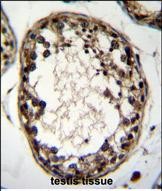OTUD1 Antibody (Center)
Affinity Purified Rabbit Polyclonal Antibody (Pab)
- SPECIFICATION
- CITATIONS
- PROTOCOLS
- BACKGROUND

Application
| WB, IHC-P, E |
|---|---|
| Primary Accession | Q5VV17 |
| Other Accession | NP_001138845.1 |
| Reactivity | Human |
| Host | Rabbit |
| Clonality | Polyclonal |
| Isotype | Rabbit IgG |
| Calculated MW | 51063 Da |
| Antigen Region | 282-311 aa |
| Gene ID | 220213 |
|---|---|
| Other Names | OTU domain-containing protein 1, DUBA-7, OTUD1, DUBA7, OTDC1 |
| Target/Specificity | This OTUD1 antibody is generated from rabbits immunized with a KLH conjugated synthetic peptide between 282-311 amino acids from the Central region of human OTUD1. |
| Dilution | WB~~1:1000 IHC-P~~1:50~100 E~~Use at an assay dependent concentration. |
| Format | Purified polyclonal antibody supplied in PBS with 0.09% (W/V) sodium azide. This antibody is purified through a protein A column, followed by peptide affinity purification. |
| Storage | Maintain refrigerated at 2-8°C for up to 2 weeks. For long term storage store at -20°C in small aliquots to prevent freeze-thaw cycles. |
| Precautions | OTUD1 Antibody (Center) is for research use only and not for use in diagnostic or therapeutic procedures. |
| Name | OTUD1 {ECO:0000303|PubMed:23827681, ECO:0000312|HGNC:HGNC:27346} |
|---|---|
| Function | Deubiquitinating enzyme that specifically hydrolyzes 'Lys- 63'-linked polyubiquitin to monoubiquitin (PubMed:23827681). Required for the stability and translation of a subset mRNAs with a high abundance of rare codons by mediating deubiquitination of 40S ribosomal protein RPS10/eS10, thereby antagonizing ZNF598-mediated 40S ubiquitination (PubMed:36445135). The abundance of rare codons in mRNAs can limit the translation rate and can lead to ribosome collisions that trigger activation of ribosome quality control (RQC) pathway by ZNF598 (PubMed:36445135). OTUD1-mediated deubiquitination prevents activation of the RQC and subsequent dissociation of ribosomes and stimulates formation of polysomes and translation (PubMed:36445135). |

Thousands of laboratories across the world have published research that depended on the performance of antibodies from Abcepta to advance their research. Check out links to articles that cite our products in major peer-reviewed journals, organized by research category.
info@abcepta.com, and receive a free "I Love Antibodies" mug.
Provided below are standard protocols that you may find useful for product applications.
Background
Deubiquitinating enzymes (DUBs; see MIM 603478) are proteases that specifically cleave ubiquitin (MIM 191339) linkages, negating the action of ubiquitin ligases. DUBA7 belongs to a DUB subfamily characterized by an ovarian tumor (OTU) domain.[supplied by OMIM].
References
Franke, A., et al. Gastroenterology 135(4):1207-1215(2008)
Kayagaki, N., et al. Science 318(5856):1628-1632(2007)
Deloukas, P., et al. Nature 429(6990):375-381(2004)
Makarova, K.S., et al. Trends Biochem. Sci. 25(2):50-52(2000)
If you have used an Abcepta product and would like to share how it has performed, please click on the "Submit Review" button and provide the requested information. Our staff will examine and post your review and contact you if needed.
If you have any additional inquiries please email technical services at tech@abcepta.com.













 Foundational characteristics of cancer include proliferation, angiogenesis, migration, evasion of apoptosis, and cellular immortality. Find key markers for these cellular processes and antibodies to detect them.
Foundational characteristics of cancer include proliferation, angiogenesis, migration, evasion of apoptosis, and cellular immortality. Find key markers for these cellular processes and antibodies to detect them. The SUMOplot™ Analysis Program predicts and scores sumoylation sites in your protein. SUMOylation is a post-translational modification involved in various cellular processes, such as nuclear-cytosolic transport, transcriptional regulation, apoptosis, protein stability, response to stress, and progression through the cell cycle.
The SUMOplot™ Analysis Program predicts and scores sumoylation sites in your protein. SUMOylation is a post-translational modification involved in various cellular processes, such as nuclear-cytosolic transport, transcriptional regulation, apoptosis, protein stability, response to stress, and progression through the cell cycle. The Autophagy Receptor Motif Plotter predicts and scores autophagy receptor binding sites in your protein. Identifying proteins connected to this pathway is critical to understanding the role of autophagy in physiological as well as pathological processes such as development, differentiation, neurodegenerative diseases, stress, infection, and cancer.
The Autophagy Receptor Motif Plotter predicts and scores autophagy receptor binding sites in your protein. Identifying proteins connected to this pathway is critical to understanding the role of autophagy in physiological as well as pathological processes such as development, differentiation, neurodegenerative diseases, stress, infection, and cancer.



